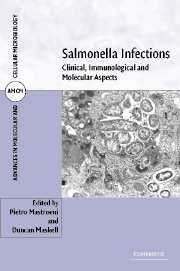Book contents
- Frontmatter
- Contents
- List of contributors
- Preface
- 1 Epidemiological and clinical aspects of human typhoid fever
- 2 Antibiotic resistance in Salmonella infections
- 3 Host-specificity of Salmonella infections in animal species
- 4 Public health aspects of Salmonella enterica in food production
- 5 The Salmonella genome: a global view
- 6 Pathogenicity islands and virulence of Salmonella enterica
- 7 In vivo identification, expression and function of Salmonella virulence genes
- 8 Mechanisms of immunity to Salmonella infections
- 9 Interactions of S. enterica with phagocytic cells
- 10 Interactions between Salmonella and dendritic cells: what happens along the way?
- 11 Immunity to Salmonella in domestic (food animal) species
- 12 Newer vaccines against typhoid fever and gastrointestinal salmonelloses
- 13 S. enterica-based antigen delivery systems
- Index
- Plate section
5 - The Salmonella genome: a global view
Published online by Cambridge University Press: 04 December 2009
- Frontmatter
- Contents
- List of contributors
- Preface
- 1 Epidemiological and clinical aspects of human typhoid fever
- 2 Antibiotic resistance in Salmonella infections
- 3 Host-specificity of Salmonella infections in animal species
- 4 Public health aspects of Salmonella enterica in food production
- 5 The Salmonella genome: a global view
- 6 Pathogenicity islands and virulence of Salmonella enterica
- 7 In vivo identification, expression and function of Salmonella virulence genes
- 8 Mechanisms of immunity to Salmonella infections
- 9 Interactions of S. enterica with phagocytic cells
- 10 Interactions between Salmonella and dendritic cells: what happens along the way?
- 11 Immunity to Salmonella in domestic (food animal) species
- 12 Newer vaccines against typhoid fever and gastrointestinal salmonelloses
- 13 S. enterica-based antigen delivery systems
- Index
- Plate section
Summary
INTRODUCTION
Genome sequences of different salmonellae are available or are close to completion providing a rich data set to support studies on these micoorganisms. Comparative sequence analysis has been used to redefine the relationships between different Salmonella species and serovars and the first functional genomic analyses have been completed. In the near future genomic studies will facilitate a redefinition of the Salmonella genus from an evolutionary perspective and we can expect novel typing systems, diagnostic approaches and possibly therapies to emerge.
FULL GENOME SEQUENCES FACILITATE THE STUDY OF SALMONELLA
The availability of full genome sequences for several Salmonella serovars has radically advanced the fields of functional and comparative Salmonella genomics. The genomic era brings an opportunity to analyze more comprehensively the phylogenetic relationships between Salmonella, the evolution of pathogenicity and the genetic variability within natural populations – comparative genomics. The precise genetic makeup of the bacterium combined with host factors are thought to account for the observed differences in the disease spectra and host specificities for different salmonellae. The recent rapid expansion of bacterial genome sequence information has enhanced our ability to investigate the activities of the genes involved on the bacterial side of this equation – functional genomics. There is hope that these genetic insights may contribute not only to a clearer understanding of Salmonella pathogenicity and epidemiology, but also to the design of better vaccines, diagnostic kits and surveillance tools.
- Type
- Chapter
- Information
- Salmonella InfectionsClinical, Immunological and Molecular Aspects, pp. 117 - 145Publisher: Cambridge University PressPrint publication year: 2006



